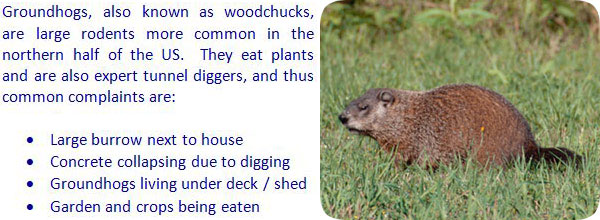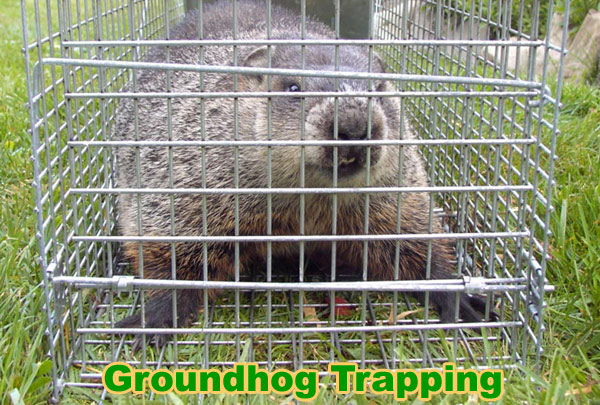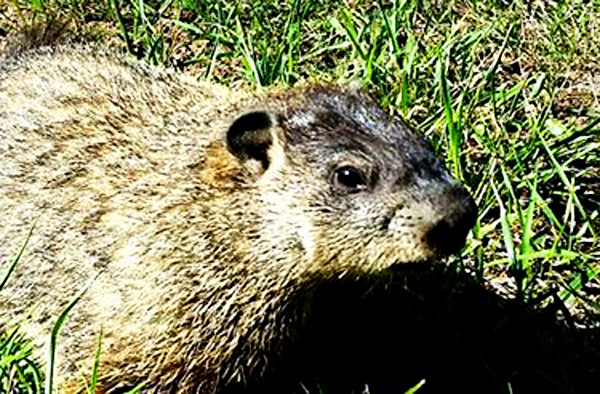- info@wildlifeanimalcontrol.com
Call us for help in your town
Wildlife Control Education
How to Catch a Groundhog in a Trap

Need groundhog removal in your hometown? We service over 500 USA locations! Click here to hire us in your town and check prices - updated for year 2020.
Live have a heart traps
The best way to catch a groundhog is with a live, or no-kill, trap. These can be found in home and garden stores in your neighborhood. A popular brand of live traps is “Havahart”. These no-kill traps allow you to catch the groundhog in a humane way and relocate them far away from your home.
Live traps work via a spring loaded door. You place the bait inside the trap, the groundhog enters to eat the bait, and their weight causes the spring loaded mechanism to snap the door closed behind them.
Baiting live traps
Taking inventory of what the groundhog has been eating comes in here. Those items are what you will use to bait your trap. So, if the groundhog is going for your heirloom tomatoes, cucumbers, or any other specific vegetation, use those to tempt the groundhog into the trap.
Bait your trap in the most effective way possible. After you buy it, set it outside in the sun for a couple of days. This will get rid of any scents lingering on the trap. You can also put it in boiling water, if you have a large enough container. Wear gloves when moving, setting and baiting the trap to hide your scent from the groundhog.

Setting your traps
Groundhogs may look like clumsy, dumb creatures. They are actually quite smart. They know when something looks or smells funny.
Late winter and early spring are the best times to find burrows. The lack of lush vegetation makes them easier to spot. The groundhogs will stop hibernating and will have to come out to search for food more often. Since their preferred food will be less abundant, they will have to come out more often.
Place your no-kill trap just outside the entrance to the groundhog’s burrow so you can catch it when it comes out to search for a meal. To quickly and effectively trap the groundhog, place logs directing the groundhog toward the trap.
If your trap is new, you will need to age it a bit so it loses its shine. Cover the trap with vegetation or a trap cover to hide it. You may need to direct the groundhog toward the trap with something called “woodchuck lure”. This is a scent that groundhogs love and will follow to the trap. Put a few drops on or around the bait as well.
There is some chatter about how to catch a groundhog with a milk jug, but it doesn't really work. But you're welcome to give it a try!
More detailed information about groundhog trapping - analysis and methods for how to trap.
Groundhogs, or woodchucks as they are often called, are usually solitary creatures, though they may occasionally live in small family groups, and should not to be confused with prairie dogs or gophers which live in clusters of a hundred or more. Still, groundhogs are capable burrowers and will create a network of tunnels that can span acres. These tunnels can pose serious threats to livestock and farm equipment; however, it is usually the groundhog that has taken up residence in a yard that is a noticeable nuisance animal.
Groundhogs are not necessarily drawn to a home because it has an ample supply of food, though gardens will sweeten the deal for a local woodchuck. The reason the groundhog has moved under your patio, deck or shed has more to do with logistics than with convenience. A burrow is easily created if there is a large support structure serving as a roof or internal brace. For this reason, decks, patios, sheds and other buildings make ideal location for groundhogs to begin their burrows. Even if it is not used for support, a building with a gap beneath it (like a modular shed or a deck) can provide shelter from the weather as well as a way to emerge from the burrow and scout the surrounding area without being in plain view.
This tendency to burrow under buildings makes getting rid of groundhogs difficult. Your neighbors may encourage you to try poison pellets, one of the most widely misused options of groundhog removal. Most of these poisons are geared toward rats. There is no federally registered groundhog poison on the market. The dilemma with this is that you don’t know what’s going to happen to the groundhog once it takes the poison, not to mention that they are very picky eaters and getting them to take poison in the first place can be next to impossible. If the groundhog retreats under your building and dies, the smell will linger for months unless the animal carcass is removed. If the large rodent dies out in the open and is then consumed by a pet, you risk secondary poisoning to your house pet.
Other methods of groundhog control center around repelling the animal or making it want to leave its network of burrows. Mothballs, a known carcinogen and a dangerous substance to humans and animals, have been proven ineffective. Even if the groundhog is offended by the smell, the animal can dig a new burrow or cover over the mothballs with a layer of dirt. Predator urine and sounds are also ineffective. A groundhog living in close proximity to humans will be cautious enough to use all of its senses, and will not just rely on its nose or ears for signs of danger. Fencing your property can be a viable option if your yard is small and the fence extends underground at an angle.
Some people get dogs with the thought that this will rid the yard of animal nuisances. In reality, a groundhog will become aggressive if cornered, and many dogs have come out the losers in fights with an angry woodchuck. Employing another animal in pest control often results in expensive veterinary visits and nothing more.
The most effective way to remove your groundhog is to trap and remove the animal. This trapping can be done with a live trap or a lethal body-gripping trap. If you are going to attempt the live trap, be prepared to relocate the animal a far enough distance away that it cannot easily return. A good relocation site should have ample food and water as well as an area enticing for burrow creation. Lethal traps can be set at the entrances to burrows. These traps will clench the animal with enough force to break its back or neck, often crushing internal organs in the process. Despite the description, most body-gripping traps are a humane way of dispatching an animal as long as they are sized properly for the job they are expected to do. With any kind of trap, the device should be left out, unset, for a few days to ensure the woodchuck is comfortable with the new surroundings. Once that comfort level has been established, the trap can be set.
More in-detail how-to groundhog removal articles:
Information about how to kill a groundhog - with poison or other methods.
Information about how to keep groundhogs away - prevention techniques.
Information about groundhog repellent - analysis of types and effectiveness.
This site is intended to provide information about how to catch a groundhog, so that you can make an informed decision
if you need to deal with a groundhog problem. This site provides many groundhog capture articles and strategies, if
you wish to attempt to solve the problem yourself. If you are unable to do so, which is likely with many
cases of groundhog removal, please go to the home page and click the USA map, where I have wildlife removal experts
listed in over 500 cites and towns, who can properly help you with your nuisance groundhog.
Click here to
read more about how to get rid of groundhogs.

What should I do with a groundhog after I catch it? - Groundhogs, sometimes called woodchucks, are very cute pelted animals that multiply rapidly in the springtime, very similar to rabbits and squirrels. Much like other wild animals, they can be a nuisance if you don’t want them on your property burrowing holes or eating your landscaping. Gardeners are especially not fond of groundhogs because they dig their holes straight into a fenced-in garden and can wreak havoc on the many plants to be found. If you live in an area with a lot of wild animals, you are no stranger to the problems that can arise from having a wild animal interact with domestic property.
Find out more: What do wildlife rehabilitators do with groundhogs?
Many people, upon discovering their groundhog problem, just call a professional. This is often the easiest way to avoid the legal issues concerning trapping, but it can be very expensive. Or, many people assume that the pest extinction companies will instantly kill the animal on site, so they plan to catch and remove the animal from their property without killing. Some people think, “The kids would love their own groundhog,” and try to keep the animal as a pet in an outdoor hutch or the like. There are legal issues surrounding all of these decisions, as wildlife is generally protected under state and federal law.
First, if you have a groundhog infestation, it is best to look up your state’s laws on catching wildlife. If it is legal to trap one, check to see which trap you need to buy - just a basic close trap or a kill trap. Sometimes, the only way to trap a groundhog is to kill it, depending on state law. Once you catch the groundhog, you need to go by state law, and humanely kill the animal. This is the case for most states, sadly. If you find that you must humanely kill the groundhog, and don’t want to do so, you can either try to scare the animal off your property, or just learn to cohabitate. Or you can always call a professional.
In some rare cases, states let you capture a groundhog and then relocate it to the proper wildlife area. Many would argue that this is the most ideal option, but it does present its own problems. You must not relocate an animal to a non-designated spot, as you may inadvertently decrease their chances of survival. If you’re lucky enough to live in a state that allows this, plan to trap the animal and then drive or walk to the location with the cage. Transportation may be interesting with a trapped wild animal in the backseat. Release the animal, and wish him or her a happy life well away from your yard!

















